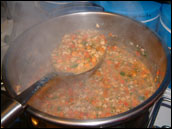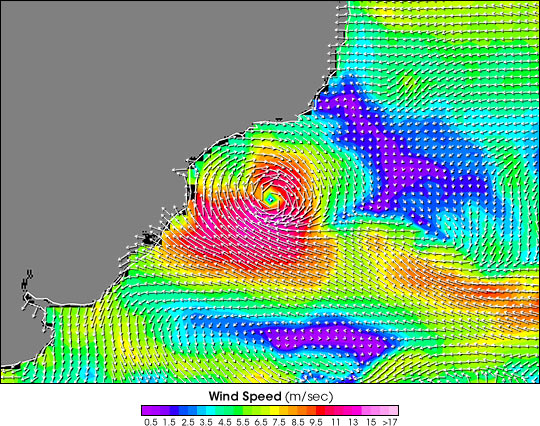

Storm Speculation: Hurricane or Not? | ||||
Exhausted, and ten pounds lighter from eating reconstituted food for more than seven weeks, all Cahalan wanted when she returned to England, was a hot shower and sleep. “You come back from these things totally wrecked,” she admits. Still, it didn’t take her long to recover enough to begin making the rounds of her meteorological colleagues to discuss the South Atlantic storm. With no formal hurricane-monitoring network in place in the South Atlantic, satellites provided the best documentation for the storm. Cahalan pored over black and white images from weather satellites and photo-like images from sensors on NASA’s Terra and Aqua satellites that revealed the size, shape and organization of the storm. Radar observations from the Tropical Rainfall Measuring Mission documented rainfall and cloud vertical structure. Back on land, Cahalan finally had the chance to see from space what she had experienced on the ocean. “The storm was very controversial,” recalls Cahalan. “Everyone was talking about it, asking ‘How had it started? Was it really a hurricane? Was it a sign of climate change?’” According to NASA meteorologist Jeff Halverson, Catarina was the subject of heated discussions at scientific meetings and conferences in the months following the event, and he suspects atmospheric scientists will be discussing it for a long time. Halverson thinks it’s likely that Catarina was out of the ordinary, but perhaps not unique. “It’s probably not the first storm like it, but it is the first verifiable hurricane-like storm in that region,” he says. | 
Yum! (Photograph copyright Nick Leggatt) | |||
 | ||||
Global Warming or Not?As to the possibility that the storm is a sign of climate instability or global warming, Halverson says you could never make that case on the basis of a single storm. Some of the speculation is fueled by other unusual happenings in the Atlantic. “In 2003, there was an unusually early start to the hurricane season, with a storm in April. And then in January 2004, there had been another storm in the South Atlantic that appeared to have tropical storm characteristics. And then there was Catarina. So you look at those three events, and that makes people wonder if we are seeing the effect of climate change. But it’s just speculation at this point.” As for Cahalan, her peripheral encounter with the out-of-place hurricane is just one of the many things she enjoys about being a professional yachtswoman. The chance to experience and learn about unusual weather is part of the joy of being at sea. Cahalan is already thinking of her next event, possibly a round-the-world race with an unusual route—one that begins and ends in Qatar and crosses the equator in the Indian, rather than the Atlantic Ocean. “That area has a totally different meteorology; for that race, the weather is all about the monsoon.” But Cahalan isn’t daunted. She looks forward to the challenge of charting a new course. |
Catarina’s high winds and organized spiral structure had all the characteristics of a hurricane. It was the first verifiable storm with these characteristics ever observed in the South Atlantic. (Image courtesy NASA/JPL Seaflux) | |||